- Joined
- Feb 26, 2009
- Messages
- 277,087
- Reaction score
- 8
I consider myself an extremely lucky angler in that I’ve had the opportunity to fish a fair few of the finest waters on this fast shrinking planet of ours. Although I’ve always had a wanderlust things really kicked off when I retired from Parliament and spent some time living in Australia back in 2010. Having experienced leaping marlin and reel screaming kingfish, barramundi and trevally it was odds on that on my return to the Thames Valley a staple diet of roach, perch, bream, chub and tench might not be quite enough to satisfy my angling desires until I’m too old to hold a rod.
In the 1990s I was fortunate to catch some very large golden Mahseer from the River Cauvery in Southern India on the stretch made famous by pioneering anglers Paul Boote and Jeremy Wade and later by John Wilson. I had a 20lb Fish on the infamous ragi paste on the first evening while still jet lagged followed later in the trip by a 76 pounder on a crab. It was that fish that lit the flame for me and fuelled a desire for fishing adventure that shows no sign of abating. Two years later I had another great trip in the company of those fine West Country anglers Andy Cowley and Stuart Morgan who remain good friends to this day. We all caught huge Mahseer including a 92 pounder to my rod which was the largest landed in the world that year.
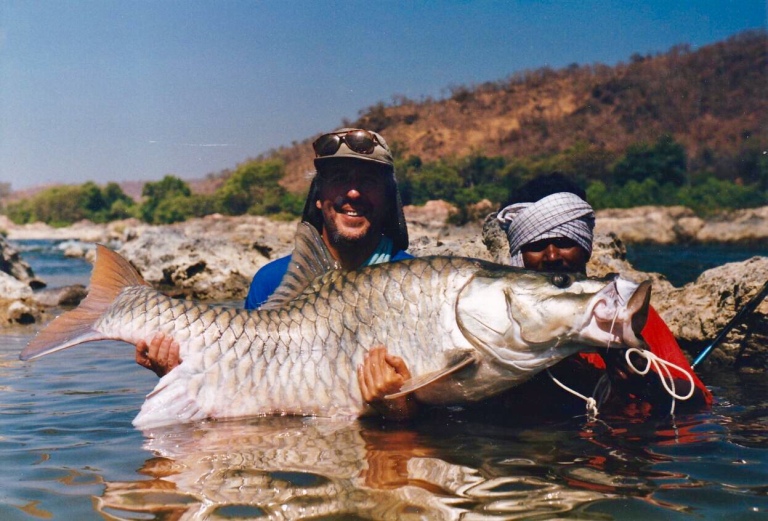
My biggest Mahseer from the River Cauvery was this 92 pounder caught in 1998. Sadly much of this river is now closed to angling.
Sadly, local politics has seen this river closed to angling and I suspect these magnificent fish are currently being poached and bombed to Hell now there’s no tourism income coming into the valley. In fact, I doubt if there are a more than a handful rivers left outside of the Himalayas that hold true golden Mahseer anymore. And even in these remote mountain areas their habitat is constantly threatened by dams and hydropower projects to feed the insatiable demand for electricity from a growing population.
The Mahseer is perhaps the greatest of all freshwater sport fishes. It lives in fast, clear waters in South Asia and is an aggressive and omnivorous apex predator. The first run of a big Mahseer is truly something to behold and it’s not uncommon to be dragged half a mile down river before these ferocious and strikingly beautiful fish can be subdued. Think salmon on steroids with the power of a giant barbel.
From 1997 to 2010 my global fishing opportunities were constrained by the demands of my constituents and the British House of Commons. However, I’ve done my best to make up for it in the last nine years with trips to Africa, South America, the Caribbean, USA, Canada, Asia and, of course, Australia. The peacock bass of the Amazon were amazing – as were the tarpon and bonefish in Cuba, the striped bass in Cape Cod, the golden dorado in Argentina, the giant sturgeon in the Fraser River and the sailfish in Kenya. But there has always been those increasingly rare, armour plated, giant scaled, golden torpedoes of the Indian Sub Continent calling me back. The Mahseer of the Himalayas (Tor putitora) is smaller and sleeker than it’s larger southern cousins (Tor mussullah) but is no less powerful and remains a worthy challenge for the angling adventurer. In the last couple of years two of our best angling adventurers, Gary Newman and Stu Walker, have both landed fish in excess of 60lbs which are huge specimens for the North.
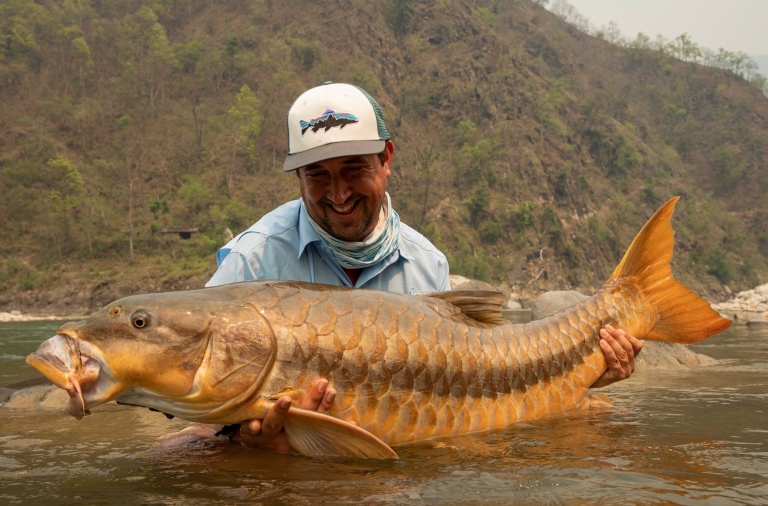
Gary Newman with 62 lbs of Himalayan mahseer from the Saryu River. One of the biggest mahseer ever caught in the region. I’m hoping for something similar in Bhutan.
In 2015 myself and regular travelling companions, Keith Elliott, Mike Robinson and Mark Edwards, had the opportunity to explore the Subansiri – a remote and rarely fished tributary of the mighty Brahmaputra River which rises in the North East state of Arunachal Pradesh near the border with China. We needed special permits to enter the area and it was a punishing five days before we even set eyes on the river. However, it was worth it for what followed was an amazing whitewater rafting trip down one of the most pristine river valleys we had ever seen. We drifted through huge sheer sided rock gorges, across boiling rapids and camped on sandy beaches beside mouth watering pools where the leopards would come to drink at night.
You can watch a film of our adventures –YouTube
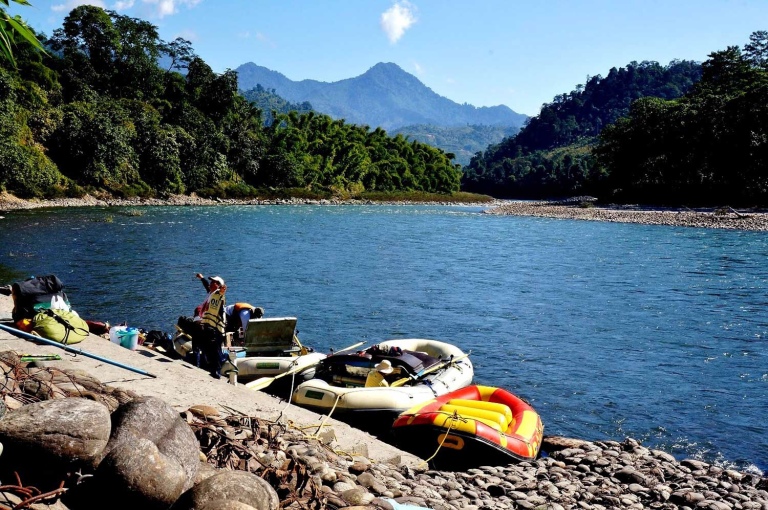
After five days of travelling we finally reached the beautiful Subansiri River.
But even here the fishing had got tougher. The western guys who first fished the river some ten years ago talked of multiple catches of Mahseer in a day. And whilst we caught some lovely fish up to 27lbs it was rare that more a couple of fish a day came out to the four of us. Even though we paddled past just one village in the whole time we were on the river there was enough occasional evidence of set lines, nets and campsite debris from previous angling trips to make us realise that the Subansiri mahseer were under pressure too. Worse still were the plans to build a giant dam at the downstream end of the river as it left the mountains which would turn much of this incredible habitat into a giant pond.
[h=3]COLOMBIAN CAPERS[/h]
We flew back to Britain wondering if we had seen the last of these great fish and looked elsewhere for our foreign fishing fixes. Earlier this year we managed to get into some pretty remote and challenging rivers in Colombia which will undoubtedly be the subject of a future article. This former narco state with its history of violence and terrorism might not be everyone’s idea of a holiday destination but believe me it has got some fabulous fishing to offer and is now a safe and upcoming angling prospect for both fresh and bluewater sport. Beto Mejia and the guys at Fish Colombia are the pioneers out there and will put you on some stunning fish.
Check out the Fish Colombia website here if you are interested.fish
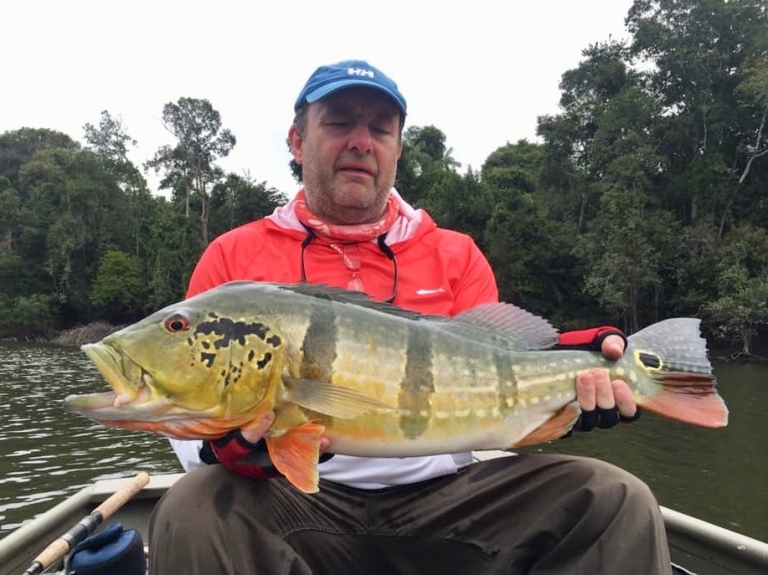
Giant Peacock Bass like this one caught by Mark Edwards can still be found in the remote rivers of Colombia
Having caught some serious peacock bass and tangled for the first time with the fearsome Payara or vampire fish we were understandably keen to return in 2020. Plans were being laid but were suddenly put on hold as once again the mountains and the mahseer intruded into our consciousness. After several years dropping hints to those in the know and making tentative enquiries of the handful of people we had met who had been there it seemed as if we had a real prospect of getting to fish in the pristine paradise that is Bhutan. A place where the rivers still run clear and where the fish have rarely seen a net or an angler.
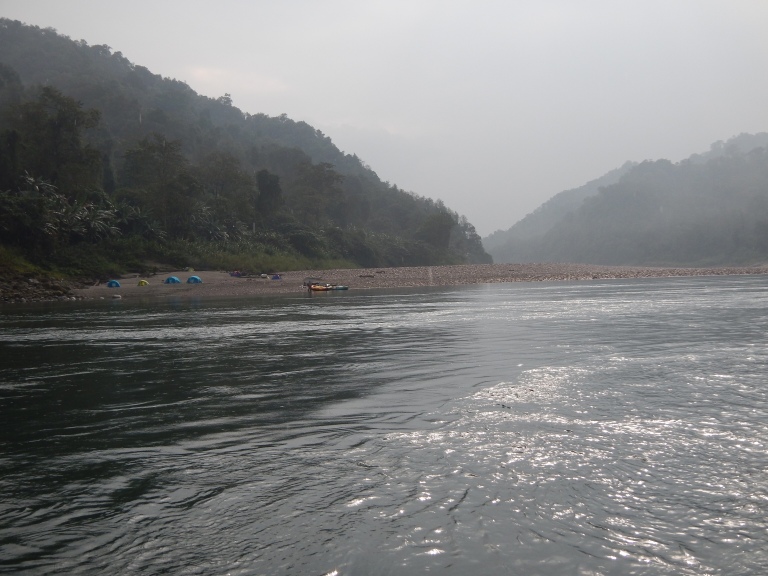
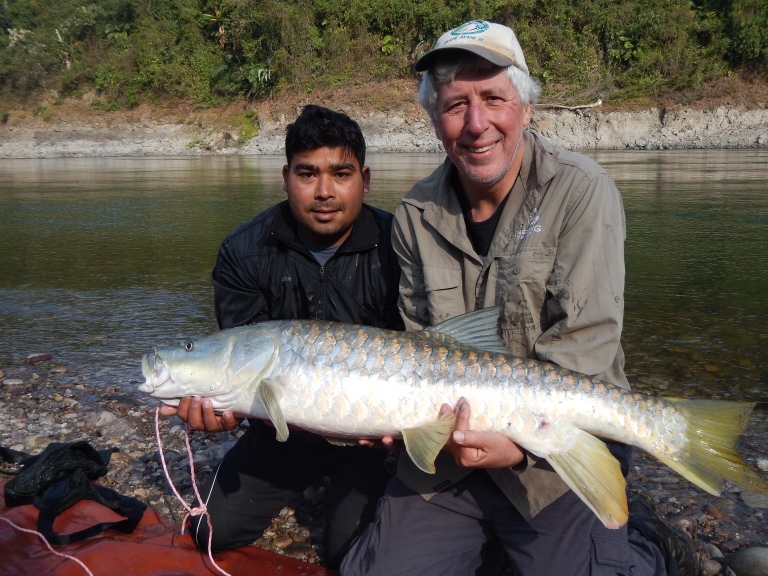
The allure of mountain rivers and the mighty mahseer is never far away
[h=3]NEXT STOP – BEAUTIFUL BHUTAN[/h]
With many Indian rivers struggling to maintain ever diminishing populations of mahseer the remote and inaccessible rivers of the tiny kingdom of Bhutan is probably the best prospect left for those of us still bitten with the mahseer bug.
Bhutan is a small landlocked Himalayan kingdom sandwiched between India to the south and Tibet in the north. It has strict environmental policies and most of its natural heritage, including its mahseer rivers, remains intact. Tigers and leopards are present along with brown bears and plentiful bird life. The population is less that 800,000 and the country is famous for only having television since 1999 and for introducing the concept of ‘gross national happiness’. In a monarchy like Bhutan having the mahseer considered a ‘royal fish’ has further guaranteed its protection and has led to a pioneering project between WWF and the Bhutanese government to develop strategies to protect the species as the country slowly develops.
There’s a great little film on their efforts which you can see here –Why the rare golden mahseer is thriving in Bhutan
There was no way that our wallets could have coped with trips to both Colombia and Bhutan so the peacock bass have been put on the back burner for another year.
Although this season has been kind to me on my local waters I’m still counting the days to next April when that plane banks past the snow capped peaks of Everest and drops down through the clouds into a land of crystal clear water and pristine mountain rivers holding these ‘tigers of the river’.
Martin Salter
Source Article...
In the 1990s I was fortunate to catch some very large golden Mahseer from the River Cauvery in Southern India on the stretch made famous by pioneering anglers Paul Boote and Jeremy Wade and later by John Wilson. I had a 20lb Fish on the infamous ragi paste on the first evening while still jet lagged followed later in the trip by a 76 pounder on a crab. It was that fish that lit the flame for me and fuelled a desire for fishing adventure that shows no sign of abating. Two years later I had another great trip in the company of those fine West Country anglers Andy Cowley and Stuart Morgan who remain good friends to this day. We all caught huge Mahseer including a 92 pounder to my rod which was the largest landed in the world that year.

My biggest Mahseer from the River Cauvery was this 92 pounder caught in 1998. Sadly much of this river is now closed to angling.
Sadly, local politics has seen this river closed to angling and I suspect these magnificent fish are currently being poached and bombed to Hell now there’s no tourism income coming into the valley. In fact, I doubt if there are a more than a handful rivers left outside of the Himalayas that hold true golden Mahseer anymore. And even in these remote mountain areas their habitat is constantly threatened by dams and hydropower projects to feed the insatiable demand for electricity from a growing population.
The Mahseer is perhaps the greatest of all freshwater sport fishes. It lives in fast, clear waters in South Asia and is an aggressive and omnivorous apex predator. The first run of a big Mahseer is truly something to behold and it’s not uncommon to be dragged half a mile down river before these ferocious and strikingly beautiful fish can be subdued. Think salmon on steroids with the power of a giant barbel.
From 1997 to 2010 my global fishing opportunities were constrained by the demands of my constituents and the British House of Commons. However, I’ve done my best to make up for it in the last nine years with trips to Africa, South America, the Caribbean, USA, Canada, Asia and, of course, Australia. The peacock bass of the Amazon were amazing – as were the tarpon and bonefish in Cuba, the striped bass in Cape Cod, the golden dorado in Argentina, the giant sturgeon in the Fraser River and the sailfish in Kenya. But there has always been those increasingly rare, armour plated, giant scaled, golden torpedoes of the Indian Sub Continent calling me back. The Mahseer of the Himalayas (Tor putitora) is smaller and sleeker than it’s larger southern cousins (Tor mussullah) but is no less powerful and remains a worthy challenge for the angling adventurer. In the last couple of years two of our best angling adventurers, Gary Newman and Stu Walker, have both landed fish in excess of 60lbs which are huge specimens for the North.

Gary Newman with 62 lbs of Himalayan mahseer from the Saryu River. One of the biggest mahseer ever caught in the region. I’m hoping for something similar in Bhutan.
In 2015 myself and regular travelling companions, Keith Elliott, Mike Robinson and Mark Edwards, had the opportunity to explore the Subansiri – a remote and rarely fished tributary of the mighty Brahmaputra River which rises in the North East state of Arunachal Pradesh near the border with China. We needed special permits to enter the area and it was a punishing five days before we even set eyes on the river. However, it was worth it for what followed was an amazing whitewater rafting trip down one of the most pristine river valleys we had ever seen. We drifted through huge sheer sided rock gorges, across boiling rapids and camped on sandy beaches beside mouth watering pools where the leopards would come to drink at night.
You can watch a film of our adventures –YouTube

After five days of travelling we finally reached the beautiful Subansiri River.
But even here the fishing had got tougher. The western guys who first fished the river some ten years ago talked of multiple catches of Mahseer in a day. And whilst we caught some lovely fish up to 27lbs it was rare that more a couple of fish a day came out to the four of us. Even though we paddled past just one village in the whole time we were on the river there was enough occasional evidence of set lines, nets and campsite debris from previous angling trips to make us realise that the Subansiri mahseer were under pressure too. Worse still were the plans to build a giant dam at the downstream end of the river as it left the mountains which would turn much of this incredible habitat into a giant pond.
[h=3]COLOMBIAN CAPERS[/h]
We flew back to Britain wondering if we had seen the last of these great fish and looked elsewhere for our foreign fishing fixes. Earlier this year we managed to get into some pretty remote and challenging rivers in Colombia which will undoubtedly be the subject of a future article. This former narco state with its history of violence and terrorism might not be everyone’s idea of a holiday destination but believe me it has got some fabulous fishing to offer and is now a safe and upcoming angling prospect for both fresh and bluewater sport. Beto Mejia and the guys at Fish Colombia are the pioneers out there and will put you on some stunning fish.
Check out the Fish Colombia website here if you are interested.fish

Giant Peacock Bass like this one caught by Mark Edwards can still be found in the remote rivers of Colombia
Having caught some serious peacock bass and tangled for the first time with the fearsome Payara or vampire fish we were understandably keen to return in 2020. Plans were being laid but were suddenly put on hold as once again the mountains and the mahseer intruded into our consciousness. After several years dropping hints to those in the know and making tentative enquiries of the handful of people we had met who had been there it seemed as if we had a real prospect of getting to fish in the pristine paradise that is Bhutan. A place where the rivers still run clear and where the fish have rarely seen a net or an angler.


The allure of mountain rivers and the mighty mahseer is never far away
[h=3]NEXT STOP – BEAUTIFUL BHUTAN[/h]
With many Indian rivers struggling to maintain ever diminishing populations of mahseer the remote and inaccessible rivers of the tiny kingdom of Bhutan is probably the best prospect left for those of us still bitten with the mahseer bug.
Bhutan is a small landlocked Himalayan kingdom sandwiched between India to the south and Tibet in the north. It has strict environmental policies and most of its natural heritage, including its mahseer rivers, remains intact. Tigers and leopards are present along with brown bears and plentiful bird life. The population is less that 800,000 and the country is famous for only having television since 1999 and for introducing the concept of ‘gross national happiness’. In a monarchy like Bhutan having the mahseer considered a ‘royal fish’ has further guaranteed its protection and has led to a pioneering project between WWF and the Bhutanese government to develop strategies to protect the species as the country slowly develops.
There’s a great little film on their efforts which you can see here –Why the rare golden mahseer is thriving in Bhutan
There was no way that our wallets could have coped with trips to both Colombia and Bhutan so the peacock bass have been put on the back burner for another year.
Although this season has been kind to me on my local waters I’m still counting the days to next April when that plane banks past the snow capped peaks of Everest and drops down through the clouds into a land of crystal clear water and pristine mountain rivers holding these ‘tigers of the river’.
Martin Salter
Source Article...
Last edited by a moderator:
